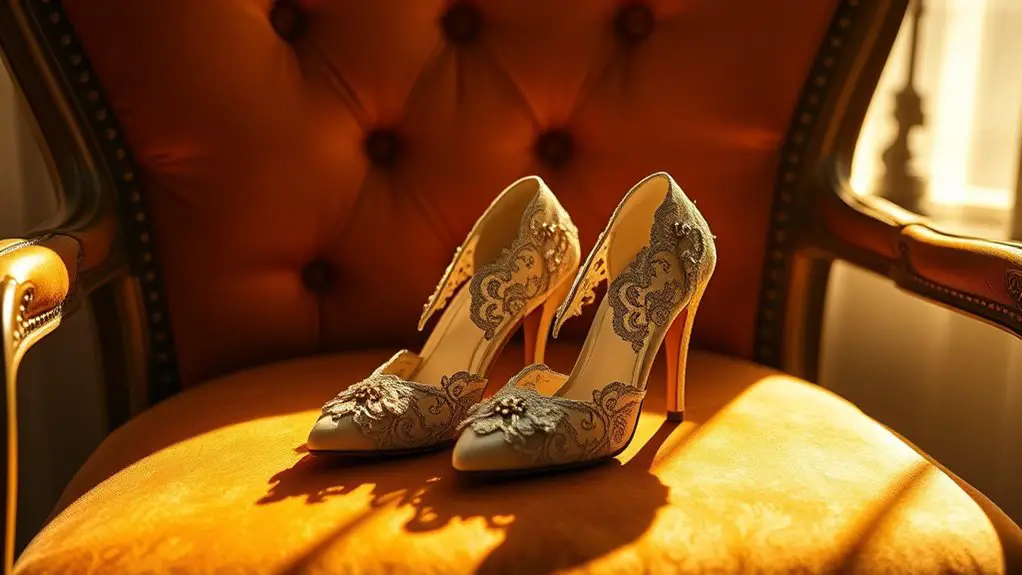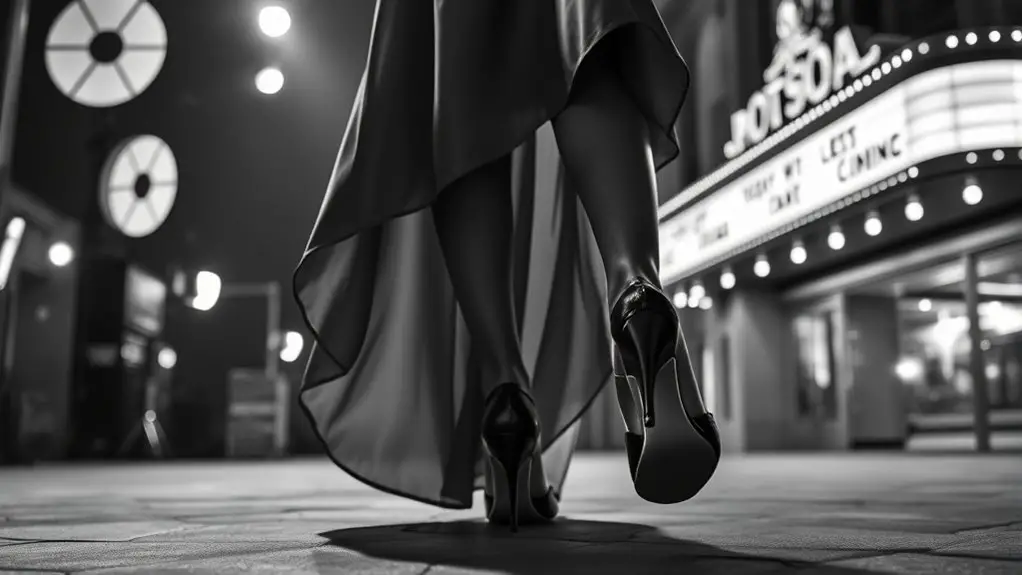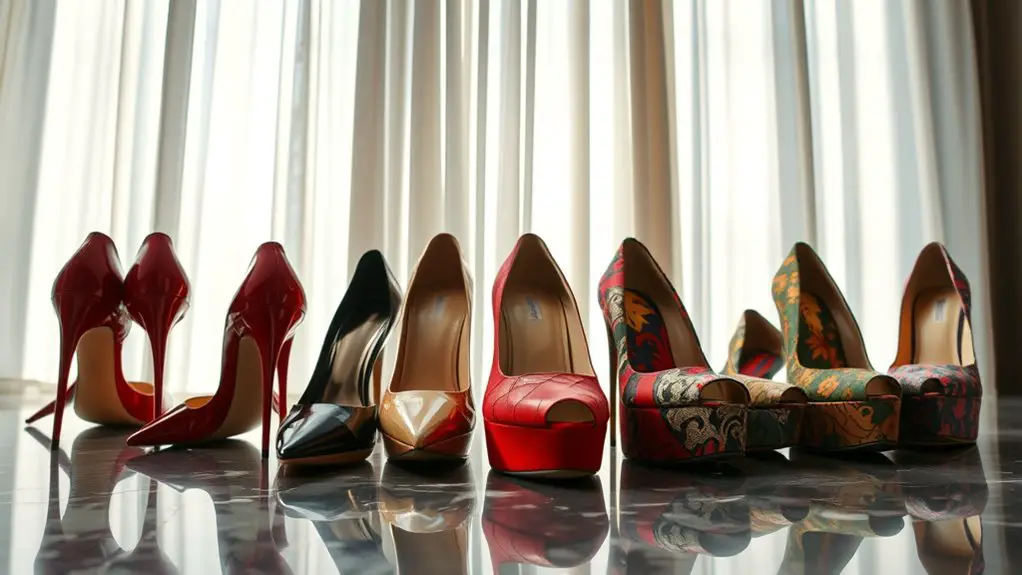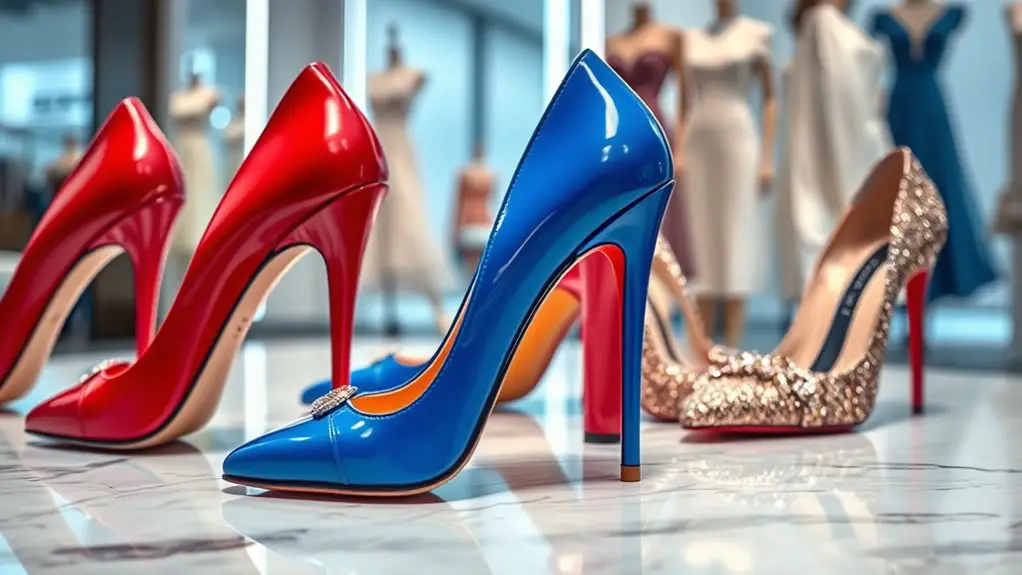High heels started as practical footwear for men in the 10th century, evolving into a symbol of power and status. By the late 19th century, as women sought equality, heels shifted into a feminine fashion staple, reflecting changing societal roles. Hollywood played a pivotal role in popularizing heels through iconic stars, further cementing their cultural significance. This transformation showcases the complex relationship between fashion and identity, revealing how heels became a beacon of empowerment in women’s lives. There’s much more to explore on this fascinating journey.
The Origin of High Heels: A Historical Perspective

Although high heels are often associated with modern femininity, their origins trace back to the 10th century when they were initially worn by men, particularly Persian cavalry, to help secure their feet in stirrups. This ancient footwear was not merely functional; it carried significant societal symbolism. As high heels evolved, they changed into a statement of power and status, particularly among the elite. In Europe, during the late Middle Ages, nobility adopted them to signify wealth and sophistication. You might find it fascinating that these elevated shoes began to reflect broader societal values, intertwining with gender roles over centuries. The shift towards high heels as a feminine fashion staple emerged later, as women began to embrace them to convey elegance and allure. Consequently, high heels transformed from practical gear to an emblem of femininity, showcasing the dynamic interplay of fashion and cultural identity through history.
High Heels in the 17th Century: A Men’s Fashion Statement
In the 17th century, high heels emerged as a bold fashion choice for men, signaling status and sophistication in aristocratic circles. You’ll find that these elevated shoes not only enhanced stature but also served practical purposes, such as improving stability on uneven surfaces. This intersection of practicality and prestige highlights how high heels were more than just a style; they were integral to the identity of the elite male wardrobe.
Origins of High Heels
High heels, often seen today as a hallmark of feminine fashion, actually emerged in the 17th century as a bold statement of masculinity. During this period, high heels were more than just footwear; they were status symbols that conveyed power and prestige among men. Influenced by ancient footwear, these elevated shoes were designed to enhance stature and assert dominance.
- High heels were initially worn by aristocratic men.
- They indicated social status and wealth.
- The design often featured intricate details and embellishments.
- Men utilized heels for practical purposes in riding and combat.
As these trends evolved, the perception shifted, ultimately leading to the feminine association we recognize today.
Aristocratic Male Fashion
While many may associate high heels with women’s fashion today, they were once a critical element of aristocratic male attire in the 17th century. During this era, high heels symbolized status and power, allowing men to elevate their stature—both literally and socially. Aristocratic attire often included elaborate garments, and heels complemented these outfits, enhancing the overall silhouette. As fashion evolved, the styles of heels varied, from chunky to delicate, reflecting the wearer’s wealth and taste. The adoption of high heels by men not only challenged gender norms but also showcased the intricate relationship between fashion and societal hierarchy. Consequently, high heels served as a potent emblem of masculinity during a time when appearances dictated one’s standing in the aristocratic world.
Practicality and Status
Although high heels are often viewed through a contemporary lens as a purely feminine accessory, their origins in the 17th century reveal a complex interplay between practicality and status for men. Back then, high heels served both functionality versus fashion, allowing aristocratic men to elevate their social status. Here are four key aspects of this dynamic:
- Height Advantage: High heels visually lengthened the legs, projecting power and authority.
- Stability: They provided a stable platform for riding horses, showcasing practicality.
- Material Quality: Luxurious materials signified wealth and prestige, reinforcing social status.
- Fashion Trends: As styles evolved, high heels began to symbolize sophistication and refinement among the elite, merging utility with elevated fashion.
The Shift to Women’s Fashion: The Late 19th Century
As the 19th century drew to a close, societal norms surrounding women’s fashion began to undergo a significant change, reflecting broader changes in women’s roles and identities. The rise of feminist movements challenged traditional expectations, urging women to embrace a more active lifestyle. You’d notice that corsets and heavy fabrics started to give way to lighter, more practical attire, allowing women greater freedom of movement. High heels emerged as a symbol of femininity, simultaneously conforming to and subverting societal expectations. They accentuated elegance and femininity, while also representing women’s newfound assertiveness. This period marked a notable departure from purely decorative fashion; heels became a statement of empowerment. As women sought to redefine their identities, high heels became intertwined with aspirations for equality, encapsulating the complex relationship between fashion and the evolving perception of women in society. Hence, high heels evolved from mere footwear to a potent symbol of women’s growing autonomy.
The Role of Hollywood: Glamour and High Heels

Hollywood has long been a powerful influencer of fashion trends, particularly when it comes to the iconic high heel. The interplay between Hollywood glamour and high heels has transformed them into a symbol of femininity. As you explore this relationship, consider the following points:
- Celebrity Influence: Stars like Marilyn Monroe and Audrey Hepburn popularized high heels, making them essential to their iconic roles.
- Fashion Icons: Modern figures, such as Lady Gaga and Beyoncé, continue this legacy, showcasing high heels on the red carpet.
- Film Representations: Movies often depict strong female characters in high heels, reinforcing their cultural significance.
- Style Evolution: The shift from practical to extravagant high heels reflects broader societal changes in women’s fashion.
High Heels as Symbols of Empowerment in the 20th Century
High heels emerged as potent symbols of empowerment for women throughout the 20th century, reflecting broader cultural shifts and societal transformations. As you navigate through the decades, you’ll notice how high heels became more than just a fashion choice; they turned into feminist statements. In an era where women began to assert their independence, slipping on a pair of heels often represented a bold assertion of self-confidence and femininity. The height and elegance they offered didn’t just elevate stature but also social status, allowing women to challenge traditional gender roles. The connection between high heels and empowerment was particularly pronounced during the feminist movements, where they became a way for women to reclaim their bodies and express agency. Within this framework, high heels are not merely footwear; they embody a complex interplay of societal expectations and the desire for liberation, marking a significant evolution in women’s fashion and identity.
The Evolution of Styles: From Stilettos to Platforms

When you consider the historical origins of high heels, it’s fascinating how styles have transformed from the elegant stiletto to the bold platform. Iconic trends in stiletto heels not only redefined femininity but also showcased changing societal norms, while the rise of platform shoes introduced a new level of comfort and attitude. This evolution reflects broader cultural shifts and the ongoing dialogue about women’s fashion and identity.
Historical Origins of Heels
Although heels are often associated with modern femininity, their historical origins reveal a much more complex evolution that spans centuries and cultures. Heels began as practical ancient footwear, initially worn by Persian cavalrymen to secure their feet in stirrups. Over time, they morphed into symbols of status and gender symbolism, particularly among European aristocracy.
Here are key points in the evolution of heels:
- Ancient Origins: Used in warfare and practicality before becoming fashionable.
- Renaissance Influence: Heels became a mark of nobility and wealth in Europe.
- Gendered Styles: Initially unisex, they evolved to signify femininity.
- Modern Adaptations: Contemporary styles reflect a blend of tradition and innovation, defining current fashion.
Iconic Stiletto Trends
The journey of heels has taken a distinctive turn with the rise of stiletto styles, which epitomize the interplay between fashion and femininity. Stiletto designs emerged in the mid-20th century, characterized by their slender heels and elegant silhouettes. These iconic styles transformed the way women expressed power and allure through footwear. From the classic black stiletto to bold prints and colors, each design tells a story of evolving beauty standards. Designers like Manolo Blahnik and Christian Louboutin have further cemented the stiletto’s status, blending artistry with functionality. You can see how these heels have become symbols of empowerment, allowing women to navigate various social and professional landscapes while making a striking statement about their identity and confidence.
Rise of Platform Shoes
Platform shoes have surged in popularity, marking a significant shift in footwear fashion that contrasts with the sleek stiletto. This platform evolution reflects changing fashion trends, as women seek both style and comfort.
- Height without Discomfort: Platforms provide elevation while distributing weight more evenly.
- Versatile Designs: Available in various styles, platforms can complement casual and formal attire.
- Cultural Influences: From disco to modern streetwear, platforms have become a symbol of self-expression.
- Inclusivity in Fashion: Platforms appeal to a broader audience, embracing diverse body types and personal styles.
As you explore the rise of platform shoes, you’ll notice how they embody a blend of practicality and aesthetic appeal, reshaping the narrative around feminine footwear.
Cultural Impact and Global Variations of High Heels
As high heels have evolved, their cultural significance has transcended mere aesthetics, reflecting societal values and norms across various regions. You’ll find that high heels not only convey femininity but also signal status, power, and sometimes even rebellion. In different cultures, they carry unique meanings and implications.
| Region | Cultural Significance | Global Variations |
|---|---|---|
| Western | Symbol of empowerment | Stilettos and platforms |
| Middle East | Often associated with modesty | Intricate designs, lower heels |
| Asia | Blend of tradition and trend | Chunky styles, varied heights |
| Africa | Celebration of identity | Bright colors, bold designs |
These global variations showcase how high heels have adapted to local contexts, merging traditional and modern influences. As you explore these cultural nuances, you’ll see high heels as more than just footwear—they’re a powerful expression of identity.
Modern Perspectives: High Heels in Contemporary Fashion
High heels continue to play a pivotal role in contemporary fashion, with their presence felt on runways and in everyday street style alike. Today, they embody a complex interplay between trendy aesthetics and societal expectations, shaping how you express gender identity and personal style.
Consider these aspects:
- Empowerment: High heels can enhance confidence, making you feel more powerful in professional and social settings.
- Fashion Statements: Designers often utilize heels to accentuate collections, pushing boundaries of style and creativity.
- Versatility: From casual outings to formal events, they adapt to various settings, offering endless styling opportunities.
- Cultural Commentary: High heels reflect changing societal norms, challenging traditional views on femininity and self-expression.
Ultimately, as you navigate contemporary fashion, high heels remain a significant symbol, balancing personal choice with broader cultural narratives.
Frequently Asked Questions
What Materials Are Commonly Used to Make High Heels Today?
When you step into the world of high heels, you’ll find they’re crafted from a blend of luxurious leather types and innovative synthetic materials, each chosen for durability, style, and comfort, enhancing your fashionable stride.
How Do High Heels Affect Posture and Foot Health?
High heels can greatly impact your posture alignment, often leading to increased foot discomfort. The elevated position forces your body to adjust, potentially straining muscles and ligaments, which may cause long-term health issues if worn excessively.
Are There Any Notable High Heel Brands Popular Today?
Today, you’ll find luxury brands like Christian Louboutin and Manolo Blahnik alongside affordable options like Steve Madden and ASOS. Each offers unique designs, catering to diverse tastes while balancing style, comfort, and budget considerations.
How Do High Heels Vary Across Different Cultures?
High heels vary considerably across cultures, reflecting cultural significance and regional styles. In some societies, they symbolize status and femininity, while in others, they’re practical footwear. Understanding these differences enriches your appreciation of global fashion trends.
What Are Some Common Misconceptions About High Heels?
You might think high heel stereotypes only reflect femininity, but they often ignore comfort and practicality. The fashion industry’s influence shapes these perceptions, creating misconceptions that overlook diverse styles and personal choices in footwear.



